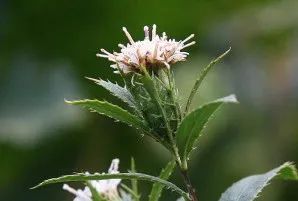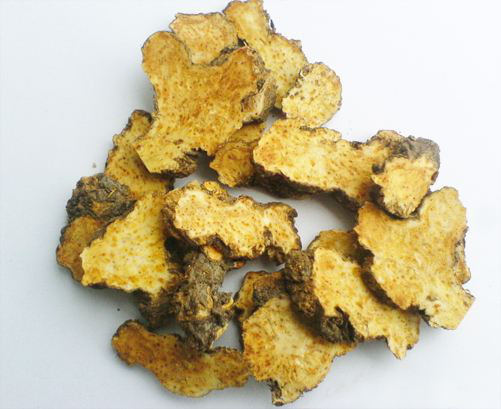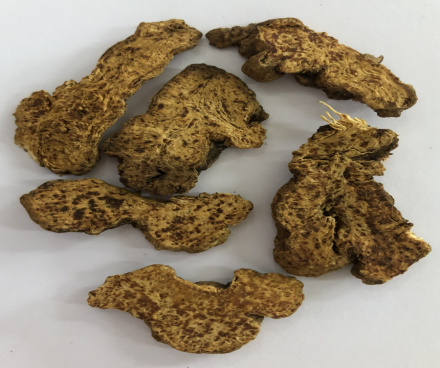Source: Zhangjiagang Traditional Chinese Medicine Hospital
In daily life, we often encounter many traditional Chinese medicinal materials. Can you recognize them all? Jiangsu Provincial Administration of Traditional Chinese Medicine has specially created the “Encyclopedia of Chinese Medicine” series to help everyone understand the Chinese herbs in daily life. Stay tuned!▼▼▼

Source
This product is the dried rhizome of the Asteraceae plant, Atractylodes lancea (Thunb.) DC. or Atractylodes chinensis (DC.) Koidz. Harvested in spring and autumn, cleaned of soil, dried, and the fibrous roots removed.
Alias
Mountain Atractylodes, Gunhead Vegetable, Mountain Thorn Vegetable.
Origin
Atractylodes lancea is mainly produced in Jiangsu, Hubei, and Henan provinces. The area around Maoshan in Jurong, Jiangsu, is known for its authentic medicinal materials. Atractylodes chinensis is primarily produced in North and Northwest China.

Identification of Characteristics
Atractylodes lancea: Irregularly bead-like or nodule-shaped cylindrical, slightly curved, occasionally branched, 3-10 cm long, 1-2 cm in diameter. Surface gray-brown, with wrinkles, transverse grooves, and residual fibrous roots, the top has stem scars or residual stem bases. Firm texture, cross-section yellow-white or gray-white, scattered with numerous orange-yellow or reddish-brown oil chambers, commonly referred to as “vermilion dots”; if exposed for a while, white needle-like crystals may precipitate, known as “frosting.” The aroma is distinctive, with a slightly sweet, spicy, and bitter taste.
Cross-section of the Rhizome ① The cork layer contains 3-8 rings of stone cells, each ring composed of 2-3 layers of stone cells. ② The cortex is broad, scattered with large oil chambers. ③ The phloem is relatively narrow. ④ The cambium forms a ring. ⑤ The xylem has fiber bundles interspersed with vessel groups. ⑥ Rays and pith are scattered with oil chambers. ⑦ Parenchyma cells contain inulin and small calcium oxalate needle crystals.
Atractylodes chinensis: Nodular or nodule-shaped cylindrical, 4-9 cm long, 1-4 cm in diameter. Surface black-brown, yellow-brown when the outer skin is removed. The texture is looser, with yellow-brown oil chambers scattered in the cross-section. The aroma is milder, with a spicy and bitter taste.
Cross-section of the Rhizome The cortex has fiber bundles; the xylem fiber bundles are larger, interspersed with vessel groups.
Properties and Channels
Spicy, bitter, warm. Enters the Spleen, Stomach, and Liver meridians.
Functions
Dries dampness, strengthens the Spleen, dispels wind and cold, and improves vision. Ancient herbal literature did not differentiate between Atractylodes and Bai Zhu (White Atractylodes), collectively referred to as Zhu, first mentioned in the Shennong Bencao Jing, classified as a superior herb. According to the Ming dynasty’s Bencao Chongyuan, “The Bencao Jing did not distinguish between Atractylodes and Bai Zhu, while Zhang Zhongjing used Bai Zhu in his Shanghan Lun formulas, and used Chi Zhu in the Jinkui Yao Lue, later in the Bielu they were divided into two, indicating that the distinction between Chi and Bai began with Zhang Zhongjing, not with Hongjing.”
Indications
This product has a strong aroma and is suitable for symptoms such as abdominal distension, fatigue, chest fullness, poor appetite, vomiting, diarrhea, phlegm-dampness, edema, exterior syndrome with dampness, heavy pain in the head and body, dampness-dominant bi syndrome, joint pain and heaviness, atrophy, night blindness, etc.
Modern pharmacological studies show that Atractylodes has liver-protective, bile-promoting, anti-ulcer, anti-cancer, and sedative effects. Atractylodes can antagonize gastric ulcers, promote liver protein synthesis, enhance bile secretion, regulate the central nervous system, lower blood sugar, and exhibit antiviral effects. Atractylodes polysaccharides have a bile-promoting effect: β-eudesmol and Atractylodes alcohol can significantly promote gastrointestinal motility, having a bidirectional regulatory effect on gastrointestinal function.

Common Combinations
(1) Dampness obstructing the Middle Jiao: This product is bitter and warm, drying dampness to dispel it, and its spicy aroma strengthens the Spleen to harmonize the Spleen and Stomach. It is most suitable for symptoms of dampness obstructing the Middle Jiao, Spleen failing to transport leading to abdominal distension, vomiting, poor appetite, diarrhea, fatigue, and a white greasy tongue coating. Commonly combined with Chen Pi (Aged Tangerine Peel), Hou Po (Magnolia Bark), etc., such as Ping Wei San (from the Heji Ju Fang). If Spleen deficiency leads to damp accumulation, phlegm-dampness or external edema, it can be used with diuretic herbs like Ze Xie (Alisma), Fu Ling (Poria), and Zhu Ling (Polyporus), such as Wei Ling Tang (from the Zheng Zhi Zhun Sheng). If damp-heat or summer-damp syndrome is present, it can be combined with heat-clearing and damp-drying herbs.
(2) Wind-damp Bi syndrome: This product is spicy and bitter, excelling in dispelling dampness, thus suitable for Bi syndrome with dampness predominating. It can be used with Yi Yi Ren (Job’s Tears), Du Huo (Angelica Pubescens), and other wind-damp dispelling herbs, such as Yi Yi Ren Tang (from the Lai Zheng Zhi Cai). If damp-heat Bi pain is present, it can be combined with Shi Gao (Gypsum), Zhi Mu (Anemarrhena), and other heat-clearing and fire-purging herbs, such as Bai Hu Jia Cang Zhu Tang (from the Pujizhen Shifang). Alternatively, it can be combined with Huang Bai (Phellodendron), Yi Yi Ren, and Niu Xi (Achyranthes) for damp-heat atrophy syndrome, known as Si Miao San (from the Cheng Fang Bian Du). If used with Long Dan (Gentiana), Huang Qin (Scutellaria), and Zhi Zi (Gardenia) for heat-clearing and damp-drying, it can treat lower body dampness, leucorrhea, damp sores, and eczema.
(3) Wind-cold with damp exterior syndrome: This product is spicy and aromatic, capable of opening the pores and inducing sweating, dispelling wind-cold exterior pathogens, and due to its ability to overcome dampness, it is most suitable for wind-cold exterior syndrome with dampness. Commonly used with Qiang Huo (Notopterygium), Bai Zhi (Angelica Dahurica), and Fang Feng (Saposhnikovia), such as Shen Shu San (from the Taiping Huimin Heji Ju Fang).
Processing Regulations
1. Atractylodes: Remove impurities, wash, moisten, cut into thick slices, and dry. Raw Atractylodes is warm and spicy, strongly drying dampness and dispelling wind, used for wind-damp Bi pain, wind-cold common cold, etc.
2. Wheat-fried Atractylodes: Take Atractylodes slices, fry according to the wheat-frying method until the surface is deep yellow. This product resembles Atractylodes slices, with a deep yellow surface, scattered with numerous brown oil chambers. It has a roasted aroma. Wheat-fried Atractylodes has a milder spicy taste, a gentler drying property, and an enhanced aromatic quality, strengthening its ability to harmonize the Spleen and Stomach, used for Spleen-Stomach disharmony, phlegm-damp stagnation, abdominal fullness, night blindness, and myopia.
3. Charred Atractylodes: Take Atractylodes slices, place in a pan, heat over medium fire until charred brown, spray with a little water, and dry over low heat, then cool and sift out debris. Charred Atractylodes significantly reduces its spicy and drying properties, primarily used to solidify the intestines and stop diarrhea. It is used for Spleen deficiency diarrhea, chronic dysentery, or women’s leucorrhea with white discharge.
Dosage
Decocted, 5-10 g.
Precautions
Contraindicated in those with Yin deficiency and internal heat, or Qi deficiency with excessive sweating.
END

Scan the QR code to follow “Jiangsu Traditional Chinese Medicine”

